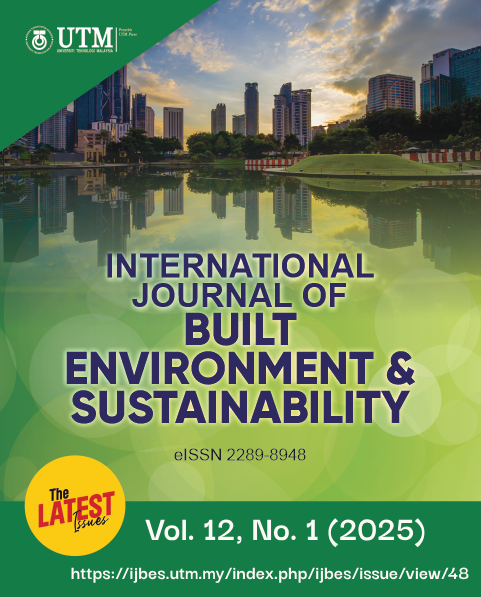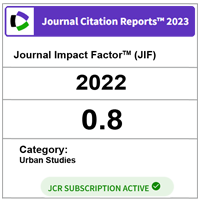Assessing Daylighting Conditions and Strategies in Residential Workspaces During the COVID-19 Pandemic: A Case Study of Apartment Buildings in Malaysia
DOI:
https://doi.org/10.11113/ijbes.v12.n1.1391Keywords:
Daylight, Visual comfort, COVID-19, Shading device, Glare.Abstract
Incorporating daylighting strategies in buildings is crucial for enhancing visual conditions, energy efficiency, and productivity. Working in an environment without windows or with limited access to daylight can negatively affect performance and lead to eye fatigue, stress, and headaches. The COVID-19 pandemic and the rapid development of IT capabilities have resulted in an increase in home-based workspaces worldwide, including Malaysia. This emerging trend, accelerated by the pandemic, has prompted people to work from their homes. Therefore, it is essential to ensure visual comfort for home workers by implementing effective daylighting strategies in their residential work environments. This study focuses on evaluating daylighting conditions in existing residential apartment buildings (RABs) in Malaysia, particularly considering their transformation into workspaces during the COVID-19 outbreak. The research methodology consists of three sequential steps; selecting and observing case studies, conducting simulation experiments, and administering a questionnaire survey. Hence, it involved observing 10 contemporary RABs in Johor Bahru, recording their facade and layout characteristics, including window shading. Then, simulation experiments were conducted by the IES-VE software to demonstrate indoor daylighting condition. Additionally, a questionnaire survey was conducted from 360 occupants of the selected RABs, utilizing multiple-choice questions and a five-point Likert scale. The collected data was analyzed using descriptive statistics. The results revealed that the lack of external window shading forced residents to rely on internal shading methods. Moreover, excessive tropical sunlight resulted in visual discomfort and glare issues for users. However, occupants predominantly utilized conventional shading options, such as curtains, leading to poorly illuminated indoor environments and increased reliance on artificial lighting for desk-related tasks. The significant findings from this research emphasize the design of flexible spatial layouts with ample open spaces along with the use of efficient internal and external shading devices in RABs, to create well-lit and healthy working environments.
References
Acosta, I., Campano, M. Á., Bellia, L., Fragliasso, F., Diglio, F., & Bustamante, P. (2023). Impact of Daylighting on Visual Comfort and on the Biological Clock for Teleworkers in Residential Buildings. Buildings, 13(10), 2562.
Awada, M., Becerik-Gerber, B., Lucas, G., & Roll, S. C. (2021). Associations among home indoor environmental quality factors and worker health while working from home during COVID-19 pandemic. Journal of Engineering for Sustainable Buildings and Cities, 2(4), 041001.
Bateman, L. (2000). Home-work. Work Study, 49(5), 198–200.
Bettaieb, D. M., & Alsabban, R. (2021). Emerging living styles post-COVID-19: housing flexibility as a fundamental requirement for apartments in Jeddah. Archnet-IJAR, 15(1). https://doi.org/10.1108/ARCH-07-2020-0144
Boyce, P. R., Veitch, J. A., Newsham, G. R., Jones, C. C., Heerwagen, J., Myer, M., & Hunter, C. M. (2006). Lighting quality and office work: two field simulation experiments. Lighting Research & Technology, 38(3), 191–223. https://doi.org/10.1191/1365782806lrt161oa
Caligiuri, P., & De Cieri, H. (2021). Predictors of employees’ preference for working from home post-pandemic. Business and Economic Research, 11(2).
Costanzo, V., Evola, G., Marletta, L., & Nascone, F. P. (2018). Application of climate based daylight modelling to the refurbishment of a school building in sicily. Sustainability (Switzerland). https://doi.org/10.3390/su10082653
Cuerdo-Vilches, T., Navas-Martín, M. Á., & Oteiza, I. (2020). A mixed approach on resilience of Spanish dwellings and households during COVID-19 lockdown. Sustainability, 12(23), 10198.
Cuerdo-Vilches, T., Navas-Martín, M. Á., & Oteiza, I. (2021). Working from home: Is our housing ready?. International Journal of Environmental Research and Public Health, 18(14), 7329.
Dahlan, N. D., Jones, P. J., Alexander, D. K., Salleh, E., & Alias, J. (2009). Daylight ratio, luminance and visual comfort assessments in typical Malaysian hostels. Indoor and Built Environment.
Djamila, H., Ming, C. C., & Kumaresan, S. (2011). Estimation of exterior vertical daylight for the humid tropic of Kota Kinabalu city in East Malaysia. Renewable Energy, 36(1), 9–15.
Dubois, M.-C. (2001). Impact of solar shading devices on daylight quality: simulations with radiance. Division of Energy and Building Design: Lund University, Sweden.
Figueiro, M. G., Steverson, B., Heerwagen, J., Kampschroer, K., Hunter, C. M., Gonzales, K., ... & Rea, M. S. (2017). The impact of daytime light exposures on sleep and mood in office workers. Sleep health, 3(3), 204-215
Freewan, A. A. Y., & Al Dalala, J. A. (2020). Assessment of daylight performance of Advanced Daylighting Strategies in Large University Classrooms; Case Study Classrooms at JUST. Alexandria Engineering Journal, 59(2), 791–802. https://doi.org/10.1016/j.aej.2019.12.049
Han, H. J., Mehmood, M. U., Ahmed, R., Kim, Y., Dutton, S., Lim, S. H., & Chun, W. (2019). An advanced lighting system combining solar and an artificial light source for constant illumination and energy saving in buildings. Energy and Buildings, 203, 109404.
Jiang, P., Van Fan, Y., & Klemeš, J. J. (2021). Impacts of COVID-19 on energy demand and consumption: Challenges, lessons and emerging opportunities. Applied energy, 285, 116441
Lim, Y.-W., & Ahmad, M. H. (2014). The effects of direct sunlight on light shelf performance under tropical sky. Indoor and Built Environment, 1420326X14536066.
Lim, Y. W., & Heng, C. Y. S. (2016). Dynamic internal light shelf for tropical daylighting in high-rise office buildings. Building and Environment, 106, 155-166.
Mangkuto, R. A., Koerniawan, M. D., & Paramita, B. (2020). The impact of courtyard and street canyon surroundings on global illuminance and estimated UV index in the tropics. Journal of Daylighting. https://doi.org/10.15627/jd.2020.16
Merzon, E., Tworowski, D., Gorohovski, A., Vinker, S., Golan Cohen, A., Green, I., & Frenkel‐Morgenstern, M. (2020). Low plasma 25 (OH) vitamin D level is associated with increased risk of COVID‐19 infection: an Israeli population‐based study. The FEBS journal, 287(17), 3693-3702.
Micaela, B. A. L. L. A. R. I. O. (2020). Telework in the EU before and after the COVID-19: where we were, where we head to Headlines.
Monzón-Chavarrías, M., Guillén-Lambea, S., García-Pérez, S., Luis Montealegre-Gracia, A., & Sierra-Pérez, J. (2021). Heating Energy Consumption and Environmental Implications Due to the Change in Daily Habits in Residential Buildings Derived from COVID-19 Crisis: The Case of Barcelona, Spain. https://doi.org/10.3390/su13020918
Morin, C. M., Carrier, J., Bastien, C., Godbout, R., & Canadian Sleep and Circadian Network. (2020). Sleep and circadian rhythm in response to the COVID-19 pandemic. Canadian Journal of Public Health, 111(5), 654-657
Mousavi, S. M. (2017). Interior Retrofit for Efficient Tropical Daylighting in Home Office Workspaces. Universiti Teknologi Malaysia.
Mousavi, S. M., Khan, T. H., & Javidi, B. (2013). Environmentally sustainable affordable design elements in housing in the context of Malaysia: Focus on middle income group. Life Science Journal, 10(3).
Mousavi, S. M., Khan, T. H., & Lim, Y.-W. (2016a). A critical review of user fit-out in habitable rooms in high-rise residential apartments in Malaysia. Asian Social Science, 12(2). https://doi.org/10.5539/ass.v12n2p184
Mousavi, S. M., Khan, T. H., & Lim, Y.-W. (2016b). Empirical validation of Radiance-IES daylight simulation for furnished and unfurnished rooms under a tropical sky. International Journal of Sustainable Building Technology and Urban Development, 7(1). https://doi.org/10.1080/2093761X.2016.1167646
Mousavi, S. M., Khan, T. H., Lim, Y. W., & Mohammadi, A. (2021). Impact of internal shading controls on efficient daylighting in home-office workspaces in tropical climates. Jurnal Teknologi, 83(6). https://doi.org/10.11113/JURNALTEKNOLOGI.V83.16635
Mousavi, S. M., Khan, T. H., & Mohammadi, A. (2021). Adjustable Internal Shading for Home Office Daylighting in Tropical Climates. International Journal of Design & Nature and Ecodynamics, 16(6), 609–624. https://doi.org/10.18280/ijdne.160601
Mousavi, S. M., Khan, T. H., & Wah, L. Y. (2018). Impact of furniture layout on indoor daylighting performance in existing residential buildings in Malaysia. Journal of Daylighting, 5(1). https://doi.org/10.15627/jd.2018.1
Muñoz-González, C., Ruiz-Jaramillo, J., Cuerdo-Vilches, T., Joyanes-Díaz, M. D., Montiel Vega, L., Cano-Martos, V., & Navas-Martín, M. Á. (2021). Natural lighting in historic houses during times of pandemic. The case of housing in the Mediterranean climate. International Journal of Environmental Research and Public Health, 18(14), 7264
Pierson, C., Wienold, J., & Bodart, M. (2018). Daylight discomfort glare evaluation with evalglare: Influence of parameters and methods on the accuracy of discomfort glare prediction. Buildings. https://doi.org/10.3390/buildings8080094
Qarnain, S. S., Sattanathan, M., Sankaranarayanan, B., & Ali, S. M. (2020). Analyzing energy consumption factors during coronavirus (COVID-19) pandemic outbreak: a case study of residential society. Energy Sources, Part A: Recovery, Utilization and Environmental Effects. https://doi.org/10.1080/15567036.2020.1859651
Ray, S., & Reddy, A. B. (2020). COVID-19 management in light of the circadian clock. Nature Reviews Molecular Cell Biology, 21(9), 494-495.
Spennemann, D. H. R. (2021). Residential architecture in a post-pandemic world: Implications of covid-19 for new construction and for adapting heritage buildings. Journal of Green Building, 16(1). https://doi.org/10.3992/jgb.16.1.199
Sulaiman, R. (2011). Developing A Malaysian Electronic Home-Based Businesses Pre-Implementation Framework: Vol. Ph.D. Ph.D Thesis, Universiti Tenaga Nasional, Malaysia.
Sulaiman, R., & Shariff, S. S. M. (2012). The Transformation of Home-Based Businesses into electronic-Home-Based Businesses. In International Conference on Economics, Business Innovation.
Tokazhanov, G., Tleuken, A., Guney, M., Turkyilmaz, A., & Karaca, F. (2021). sustainability How is COVID-19 Experience Transforming Sustainability Requirements of Residential Buildings? A Review. Sustainability. https://doi.org/10.3390/su12208732
Whitehead, R. (2009). Residential Lighting A Practical Guide to Beautiful and Sustainable Design Second Edition, John Wiley&Sons. Inc.
Wirz-Justice, A., Skene, D. J., & Münch, M. (2021). The relevance of daylight for humans. Biochemical pharmacology, 191, 114304.
Zarrabi, M., Yazdanfar, S. A., & Hosseini, S. B. (2021). COVID-19 and healthy home preferences: The case of apartment residents in Tehran. Journal of Building Engineering, 35. https://doi.org/10.1016/j.jobe.2020.102021
Zhang, Y., Zhang, Y., & Li, Z. (2022). A novel productive double skin façades for residential buildings: Concept, design and daylighting performance investigation. Building and Environment, 212, 108817.
Downloads
Published
How to Cite
Issue
Section
License
Copyright (c) 2025 International Journal of Built Environment and Sustainability

This work is licensed under a Creative Commons Attribution-NonCommercial-ShareAlike 4.0 International License.
Copyright of articles that appear in International Journal of Built Environment and Sustainability belongs exclusively to Penerbit Universiti Teknologi Malaysia (Penerbit UTM Press). This copyright covers the rights to reproduce the article, including reprints, electronic reproductions or any other reproductions of similar nature.
Authors who publish with this journal agree to the following terms:
- This Journal applies Creative Commons Licenses of CC-BY-NC-SA
- Authors retain copyright and grant the journal right of publication with the work simultaneously licensed under a Creative Commons Attribution License that allows others to share the work with an acknowledgement of the work's authorship and publication in this journal.
- Authors are able to enter into separate, additional contractual arrangements for the non-exclusive distribution of the journal's published version of the work (e.g., post it to an institutional repository or publish it in a book), with an acknowledgement of its publication in this journal.
- Authors are permitted and encouraged to post their work online (e.g., in institutional repositories or on their website) prior to and during the submission process, as it can lead to productive exchanges, as well as earlier and greater citation of published work (See The Effect of Open Access).








